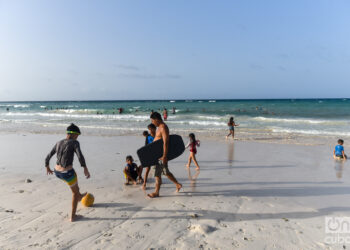The Cuban National Ballet, directed by prima ballerina assoluta Alicia Alonso, has got us used to receiving surprises of technical, good dancing taste on the stage.
Their latest performance at the García Lorca Hall of Gran Teatro de La Habana was a fine display of talent and first class dramaturgical concepts.
With the ballet La leyenda del agua grande, a choreography by young Eduardo Blanco, the company showed its potentialities to master the most ethereal classic styles as well as the body expressions of contemporary dance. Blanco succeeded in combining techniques and acting in this story of autochthonous Latin American legends, changing from one style to the other almost imperceptibly.
Based on the legendary story of the creation of the Iguazú Falls in the southern center of our continent, La leyenda… choreographically narrates the sacrifice ritual annually performed by the inhabitants of that region to Mbói Tu’I, a snake-bodied, parrot-headed monster, in prayer for better crops and good rain and water flow.
The story, consisting of a prologue and two acts, takes place during the preparations for the sacrifice of young Indian maiden Naipí, with whom the hero Tarobá, ferocious jaguar hunter, has fallen in love. The young man faces the Chief, his wife and son, trying to prevent his beloved one from being murdered by the monster. When they are about to escape together, Mbói Tu’I sees them on the sacrifice rock, and trying to capture them, with implausible force causes a crack in the rock where the river water falls in a cascade, thus separating the lovers forever. His aberrant action turns Tarobá into a palm tree and Naipí into a rock.
The stage and lighting decoration by maestro Salvador Fernández and Pedro Benítez, respectively, were excellent, permanently conveying the spirit of the events on the stage, be it the sparkle of lightning, the forest green or the sacrifice rock, in a realistic atmosphere that filled each and every one of the spaces on the stage of the Prado colossus.
The wardrobe, with creations by Frank Álvarez, and the music composed by Miguel Núñez likewise completed the crudeness and naturalness of a staging that is culturally closer to us than the great classic European landmarks, and where the inclusion of contemporary, classic and some indigenous dances combine to create an interesting trinomial.
What can be said about the dancers? The leading roles were assumed by young members of the company, faithful followers of a dancing talent tradition.
Naipí was personified by main dancer Amaya Rodríguez (on Friday and Sunday) and by prima ballerina Yanela Piñera (on Saturday). Piñera did a great job, mastering turns and extensions, at her best in an idyllic pas de deux in which she evidenced her powerful technique, still in constant development. She achieved a highly emotive interpretation of pain and suffering in the first act, which contrasted with the love tinged with fear in the second, as demanded by the piece.
Coryphaeus Luis Valle (on Friday and Sunday) and first soloist Arián Molina personified Tarobá, the hero in love. Arián is one of those dancers whose physical presence and powerful turns are imposing on the stage, and who succeeds in changing the rhythm with impressive easiness. Young Molina has undoubtedly a powerful technique, with huge jumps and extensions that endow the character with vitality and youth; his interpretation, though, fluctuates. Developing this aspect would grant greater impulse to his dancing virtuousness.
Young soloist Alejandro Silva surprised with his interpretation of Ñuatí, the Chief’s son, showing that he can become a future pillar of the company both technically and dramatically. Strength and boldness, accompanied by huge jumps, pirouettes and acrobatics, were the main assets of this young man.










